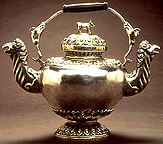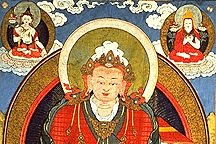|
Nomadic
Life
Mongolia:
The Legacy of Chinggis Khan begins with an exploration of Mongolia's
traditional nomadic way of life. In the landlocked steppe of Central
Asia, the Mongols since ancient times have lived in tribal groups,
enduring an extreme climate and landscape, with rugged mountains,
desert in the south, and dry steppe lands and harsh winters in the
north. The horse makes the life of a nomadic herdsman possible, and
to this day the Mongols are renowned equestrians. In the countryside
Mongols still spend much of their lives on horseback. The horse, together
with the sheep, goat, bovine, and camel, comprise the "five snouts"
of livestock, the basis of the Mongol's economy and way of life.
Nomadic life is reflected
in the arts of Mongolia. Artistic efforts and creativity were often channeled
into portable works of art such as saddles, horse trappings, and personal
jewelry. Mongolian saddles are wonderful creations encompassing such techniques
as metal casting, leather work, and embroidery. Women's jewelry is especially
striking and varies from one tribe to another. Most characteristic are
women's complex and elaborate headdresses and hair ornaments, made of
precious metals and gems such as turquoise and coral. Along with proclaiming
tribal affiliation, this jewelry was a dowry which was worn by married
women throughout their lives.
Mongolian Khans
and the Mongol Renaissance
While most Mongols
lived a little changing nomadic lifestyle, the reconversion of Mongolia
to Tibetan Buddhism in the sixteenth century resulted in a new kind of
centralized political structure in Mongolia, and evolving political relationships
with Tibet and China. Beginning in the seventeenth century, Outer Mongolia
was officially ruled by a lineage of incarnate Buddhist lamas, the Bogdo
Gegens. These high-ranking Buddhist monks ruled from Urga, the historic
capital of Outer Mongolia, modern Ulaanbaatar. Like the Dalai Lamas of
Tibet, the Bogdo Getgen were simultaneously the religious and political
heads of state. The first Bogdo Gegen, Zanabazar (1635-1723), was a direct
descendent of Chinggis and Khubilai Khan. Perhaps unique among world cultures,
Zanabazar, a celebrated monk and statesman, was also Mongolia' greatest
artist.
The Bogdo Gegens,
while the official rulers of Outer Mongolia, were in fact subordinate
to Tibetan lamas, and to the Manchu emperors of China's Qing dynasty.
Aside from Zanabazar, the only other Bogdo Gegen celebrated for his leadership
was the eighth and last of the line, known as the Bogdo Khan, whose rule
ended in 1924. Some of his lavish garments, including a spun gold jacket
and a gold-brocaded imperial robe, as well as the imperial regalia of
his wife, are on display here. Also on view are gifts to the Bogdo Gegens
from the Chinese Manchu emperors, including a ceremonial dorje
(tantric thunderbolt) and drum.
Buddhist
festivals and the second conversion
The Mongols were reconverted
to Tibetan Buddhism in the sixteenth and seventeenth centuries. This conversion
was accomplished among a dispersed, nomadic population through different
means. One was the active suppression of shamanism, the native belief
system of the Mongols, which nonetheless has persisted to the present
day. A more effective means of promoting Buddhism was the staging of large
public festivals. Buddhist monks performed tsam ceremonies, seasonal ritual
dances which were held to exorcise evil forces. The Mongolian tsam, which
was inspired by the Tibetan Buddhist cham ceremonies, had among its characters
both Buddhist deities and shamanistic figures converted to Buddhism. Elaborate
masks representing the various players in the performance are featured
in this exhibition. These singular, dramatic, multimedia creations, made
by the monks themselves, are among the greatest works produced by the
Buddhist artists of Mongolia.
The Maitreya Festival,
which honors the Buddha of the Next Age, Maitreya, was important in Tibetan
Buddhism. It took on special significance in Mongolia where it was introduced
by Zanabazar. The Maidar (Maitreya) Procession in Mongolia, depicted in
intricate detail in an early twentieth century painting, focused on a
sculptural image of Maitreya transported in a horse-headed cart. The Maitreya
Festival in Mongolia came to symbolize hope for a New Age of Mongol rule
and autonomy.
Dissemination of
the Buddhist canon in Mongolia was also essential to instituting the faith.
Fourteen elaborate book covers and manuscript pages from Buddhist sutras
show the high regard and artistic attention given to these books.
The Mongolian Pantheon
Tibetan Buddhism is
a complex ritualistic religious with a vast array of deities. The Mongolian
pantheon did not depart radically from the Tibetan one, but it did refine
and emphasize certain deities to its own ends. Among the important deities
in Mongolia are the Buddha Shakyamuni, Amitayus, Mahakala, White Tara,
and Lhamo. Especially popular was Begtse, originally a Tibetan god of
war who became one of the Great Protectors of Buddhism. He was acknowledged
as the protector of both the Bogdo Gegens of Mongolia and the Dalai Lamas
of Tibet, and, eventually, the popular special Protector of Mongolia.
Among the most spectacular
and accomplished works of this exhibition are the large Buddhist applique
Engraves depicting important figures in the pantheon. These thangkas,
created entirely of fabric, embroidery, and needlework, are among the
largest and best of such creations in the Buddhist world. A unique characteristic
of Mongolian appliques is the decoration of their surfaces with jewels.
Figures from the large pantheon are found in other media as well, including
painting, and sculpture in metal and wood.
Zanabazar
The exhibition culminates
with the work of Zanabazar (1635-1723), Mongolia's first incarnate Bogdo
Gegen and her greatest artist. Historical sources record that he worked
in several media, but it is his bronze sculptures which have earned him
the greatest renown. Influenced by the Nepalese artists who had been called
to the court of Khubilai Khan, Zanabazar created exquisite, sensuous,
and refined cast bronze images. During his lifetime he was the greatest
Buddhist sculptor in Asia.
Among his masterworks
on view are the youthful, elegant White Tara, said to be modelled after
Zanabazar's beloved consort. Sitasamvara, one of the great patron deities
of Tibeto-Mongolian Buddhism, is a miracle of multi-part casting, displaying
a delicate sensuality and great sensitivity to physical form. The majestic
Vajrasattva, a deity associated with Zanabazar and the Bogdo Gegens, is
one of the artist's largest extant works. He holds the dorje and bell,
metaphors for wisdom and compassion whose union leads to enlightenment.
---K. Youso
|





